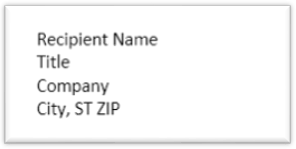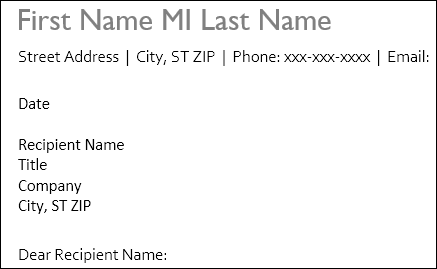Essential Parts of a Job Application Cover Letter
Applying for jobs is stressful, and having to tailor each application to the job and company in a timely manner just adds to the effort level. But if you want to stand out from the crowd of 100+ people that may apply for any job, you can’t just submit the same cover letter (or job application letter) to each hiring manager for each role.
When you’re submitting cover letters, it’s essential to get them right. From the basics, such as contact information, greeting, and salutation, to the bulk of the letter, we’ve laid out the key areas to cover and guidance for writing yours to stand out.
Note: We also have downloadable templates you can use so you don’t have to worry about coming up with your own professional designs. You can download and customize them for free from the Templates page.
As with any letter, there is an expected flow of information.
Introduction
The top part of your letter sets the stage by covering some of the common elements of a greeting and contact information.
Your Contact Information
Name, mailing address, phone number(s), email address, and any social media handles if you’d like to make it easier for the employer to check you out.
Employer Contact Information
Unlike the resume, where you don’t include information directly about the potential employer, you do in the cover letter.
Date
Include the date either after your own contact information or before the greeting. By providing the date, you can also reference it if you need to follow up with the potential employer if you haven’t heard back about an interview. Here are a few examples of where you can place the date in the introductory design.
Greeting
You need to address the letter to someone, but what do you do if you don’t know the name of the recruiter/hiring manager? First try to call or email the contact person listed on the job advertisement to see if you can find out who for sure will review your letter. That way, you show commitment to researching details and solidify your interest in the role. If that doesn’t work, you can always go with the customary “To Whom It May Concern.”
Requisition Number
When a job requisition number/identifying number is included on the job posting, you should include it somewhere within the cover letter to make it very clear the exact job you’re applying for. You can place it at the top in the introductory material, and/or mention it in the body text.
Body
The first part of the letter was easy. The next part gets a little more challenging because you need to paint a positive picture of why this company would benefit from hiring you, but you don’t just want to rehash bullet points from your resume. To write a compelling letter, you need to answer these questions/ask yourself these questions and tie your experience to the job ad and your understanding of it. Use these prompts to help build your story rather than aimlessly tossing text into paragraphs. These prompts take some of the guesswork out.
Who I Am and How That Can Improve Your Business – Introductory paragraph
Don’t speak in general terms, just saying how many years you’ve held a certain job title or where you went to school. You also don’t want to sound self-serving by saying “I want to use this role to fulfill my goal of becoming a manager” or a similar statement. You do want to show enthusiasm for the role; just be certain that how you frame it shows the benefits you bring to the employer. Have you designed a training program that has been proven to increase employee retention? Simplified a process to reduce the number of minutes it takes to complete each task? Organized a yearly charity event to benefit the local community? Consistently worked with “difficult” team members to discover they were just in the wrong department / hired for the wrong job? Show how you can repeat these accomplishments for the new employer, based on the exact requests they’ve placed in the job ad.
Before you officially put the refined details into the introductory paragraph of your cover letter, you can jot out ideas, read them out loud, and improve them. Improvements include being specific and measurable in your details, and making sure you’re speaking directly rather than sounding too formal or forced.
In this paragraph, you’ll also want to let the hiring manager know how you learned about this open position. For example, were you referred by an employee, a long-time follower of their company who noticed the open position on Twitter, or happened upon it on a job board?
How I Have Achieved Success Before and How I Can Do it for You – Second/third paragraph
In the following body paragraphs, you elaborate on how your unique skills and experience will be an asset to the company. Don’t use generic statements like “my skills would lend well to the position.” Focus on specific skills, how they match the job ad, and support your claims with actual accomplishments from your work history (measurable, quantifiable if possible).
This is the time when you need to be persuasive, even if it feels like you’re bragging and it feels uncomfortable! It’s hard for most people to frame their talents and wins in a way that is persuasive and unique without feeling big-headed or arrogant. But it’s up to you to make it clear; no one can read between the lines.
Closing
In the last paragraph, thank them for considering your application to the role and reiterate why you’re excited to contribute to the organization and its customers. Indicate when you will follow up if you have not yet heard back from the recruiter or hiring manager. This strategy is not to sound impatient or ungracious; it’s really to make sure you are committed to the entire process of working toward earning the role, and to give the heads up in a polite and professional manner that you will continue to follow through on that commitment. Follow the standard letter format to close out your cover letter. Use a professional word such as “regards/kind regards” or “sincerely” followed by your full name.
Other Things to Consider
Length
Keep the cover letter to one page. Even though the pages allowed has changed for resumes, you don’t need to drone on for more than a page in the letter.
Design
You don’t need to spend money hiring and expensive graphic designer or professional career material creator, but do use some basic design elements to make the letter look professional. Simply using a letterhead template in your word processor or looking up standard letter formats on the web will guide you into clear design.







